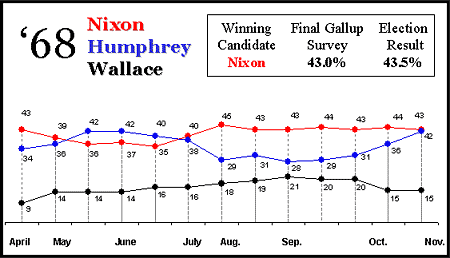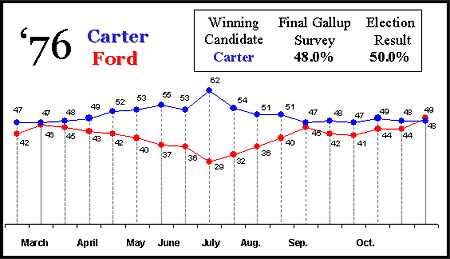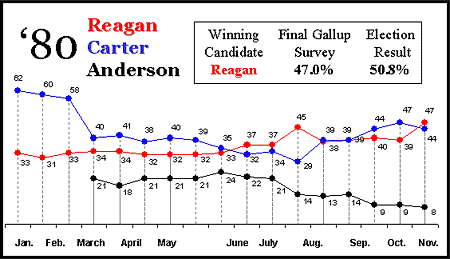GALLUP NEWS SERVICE
PRINCETON, NJ -- There have been several presidential elections over the last 40 years that have either been close in pre-election polls taken during the fall, or ended up being close. As the race between George W. Bush and Al Gore moves back and forth in the final phase of the 2000 presidential campaign, a look back on previous close elections suggests that even at this late point in the campaign, it is difficult to predict the eventual winner.
It is often reported, for example, that the 2000 contest resembles 1960 when an incumbent vice president, Richard M. Nixon, faced a strong challenge from John F. Kennedy. That election ended up being extremely close, but was not the only election that was within the margin of error through the final days. Elections in 1968, 1976 and 1980 were also within three percentage points in the closing days of the campaign.
What follows is a look back at these four elections.
1960
In 1960 Nixon and Kennedy debated on four separate occasions,
culminating on Oct. 21. A Gallup poll during that period from Oct.
18-23 showed Kennedy with 49% and Nixon with 45% of the vote,
virtually equal to polls taken just prior to the second debate on
Oct. 7. The final poll conducted just prior to the election showed
a very tight race, with Kennedy ahead by just two percentage
points. After the final ballots were tallied, the challenger had
indeed outlasted the incumbent vice president, but by only
two-tenths of one percent of the national vote. In short, the very
tight race shown in pre-election polls taken during the fall of
1960 were indeed indicative of the final result.

1968
The 1968 election placed Richard M. Nixon again in a close contest,
this time in a three-way race against incumbent Vice President
Hubert Humphrey, and third-party candidate George Wallace. Humphrey
gained the Democratic nomination after an unpopular President
Lyndon B. Johnson announced that he would not seek it. While the
parallel to the present day cycle is not exact - Bill Clinton's job
approval rating remains high despite a poor personal rating - both
incumbent vice presidents, Humphrey then and Gore today, are
running independently of their presidents in tight races. Nixon and
Humphrey did not debate, but polls taken in mid-October showed
Nixon (with 44% of the vote) ahead of Humphrey (36%) and Wallace
(15%). However, the final poll taken Oct. 31 through Nov. 2 trimmed
Nixon's lead to one point over Humphrey. On Election Day, the
result was a .7% victory for Nixon over Humphrey. Here, then, was a
situation in which a candidate ahead by eight points in October
lost the lead and barely managed to win when the final tally was
taken.

1976
In 1976 incumbent President Gerald Ford, who had ascended to the
presidency after Nixon's resignation in August 1974, attempted to
hold the White House against Jimmy Carter, who held a substantial
lead from April through the Republican convention, averaging 12
points over seven polls. Despite frequent assertions from
journalists that a foreign policy gaffe by Ford in the debates had
hurt his campaign, the momentum was shifting away from Carter
during October. Ford closed to within six points just after the
second debate, within five points right after the third and final
debate, and to within four points on Oct. 28 through 30. The final
poll in early November indicated a very close race, with Ford
holding a one-point margin, and on Election Day it was Carter who
won the White House in a very close race, 50% to 48%. Again, as was
the case in 1968, a candidate with a more substantial lead earlier
in the campaign found the final election to have closed on a very
close margin.

1980
The most recent close election was in 1980, when Jimmy Carter
attempted to defend his presidency against another governor, Ronald
Reagan, and independent candidate, John Anderson. Despite a poor
economy and a hostage crisis in Iran, the Carter campaign began
with a Carter edge through May. The race flipped after the
Republican convention, but drew to a tie at 39% in polls taken on
Aug. 15-18 after the Democratic convention. At this point,
Anderson's presence was clearly being felt as he was polling at
14%. Again, despite the commentary of the time that had Reagan
besting Carter in the debate, two consecutive polls taken in mid-
and late-October suggested that Carter maintained a four- then
eight-point advantage. But, that margin did not hold. The race
closed, and Gallup's final poll taken Nov. 2-3 showed a reversal in
the lead in favor of Reagan by three points. Reagan's momentum
continued, and he went on to win by a 10-point margin. This 1980
election is one of the most striking examples of how quickly a race
can change in the final end game of a campaign. What looked like a
solid Carter lead evaporated, and the incumbent president ended up
losing by a significant margin.

2000
If there is one moral in this story for the current election, it is
that things may well change, and change significantly, between now
and Election Day. The current race has been through several
distinct phases since Labor Day, with Gore enjoying a lead in
September, with a period of time during which the race was even,
and then - beginning at about the time of the first debate in
October - a phase during which George W. Bush has either been in
the lead or tied. As of the latest CNN/USA Today/Gallup tracking
estimate from Oct. 22-24, Bush has a slight lead over Gore, 48% to
43%. Still, history certainly suggests that there is no certainty
about what will happen between now and Election Day. Bush may well
maintain his edge and win the White House, or, it may just as well
be that Gore will charge back. As previous elections have shown,
two weeks is an eternity in a presidential campaign in late October
and early November.
Survey Methods
These results are based on historical Gallup polls from telephone
interviews with randomly selected national samples from 1960
through 2000. In addition to sampling error, question wording and
practical difficulties in conducting surveys can introduce error or
bias into the findings of public opinion polls.
Results are based on telephone interviews with 1,223 National Adults, aged 18+, conducted Oct. 22-24, 2000. For results based on the total sample of National Adults, one can say with 95% confidence that the margin of sampling error is +/- 3 percentage points.
Results based on the subsample of 974 people who indicate they are registered to vote have a margin of sampling error of +/- 3 percentage points.
Results based on likely voters are based on the subsample of 735 survey respondents deemed most likely to vote in the November 2000 General Election, according to a series of questions measuring current voting intentions and past voting behavior. For results based on the total sample of Likely Voters, one can say with 95% confidence that the margin of sampling error is +/- 4 percentage points.